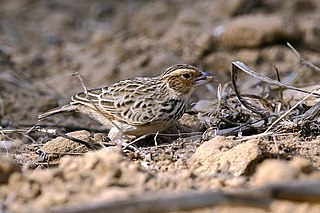
The Bengal bush lark or Bengal lark is a species of lark in the family Alaudidae found in southern Asia.

Jerdon's bush lark or Jerdon's lark is a species of lark in the family Alaudidae found in south Asia. This was formerly considered as a subspecies of Mirafra assamica and termed as the Madras bushlark. Two other species in the complex include Mirafra marionae and Mirafra microptera. Jerdon's bush lark is typically very pale on the underside

The singing bush lark or Horsfield's bush lark is a species of lark which inhabits grassland throughout most of Australia and much of Southeast Asia. It was described by the American naturalist Thomas Horsfield.

The Indian bush lark is a species of lark in the family Alaudidae found in South Asia.

The pale-billed sicklebill is a species of sicklebill that belongs to the family Paradisaeidae, which contains the birds-of-paradise.

Wallace's fruit dove is a species of a bird in the pigeon family Columbidae. The name commemorates the British naturalist Alfred Russel Wallace. It is a rather large, long-tailed fruit dove with a length of 24–28 cm (9.4–11.0 in) and has been described as "one of the most beautiful" fruit doves. The forehead and crown are dull crimson, the lower face and throat are white, and the rest of the head, breast, neck, and upper back are pale bluish-grey. The wings and lower back are green and the belly is orange, separated from the chest by a white band. Both sexes look similar, but females have less extensive red on the head and a greenish tinge to their grey parts.

The Cape clapper lark is a small passerine bird which breeds in southern Africa. It derives its name from the wing clapping which forms part of the display flight. The Cape clapper lark is a species of open grassland and savannah, also inhabiting karoo, fynbos and fallow agricultural land.

The collared lark or collared bushlark is a species of lark in the family Alaudidae found in East Africa.

Gillett's lark or Gillett's bushlark is a species of lark in the family Alaudidae found in eastern Africa.

The red-winged lark is a species of lark in the family Alaudidae found in eastern Africa. It was formerly treated as conspecific with the Kidepo lark.

The Burmese bush lark or Burmese lark, is a species of lark in the family Alaudidae found in Southeast Asia.

The monotonous lark is a species of lark in the family Alaudidae found in southern Africa.

The pink-breasted lark or pink-breasted bushlark is a species of passerine bird in the family Alaudidae.

The flappet lark is a species of lark in the family Alaudidae that is widespread across Sub-Saharan Africa. The name flappet originates from the distinctive wing flapping sound made during its breeding season.

The Somali lark is a species of lark in the family Alaudidae endemic to Somalia. Ash's lark is now considered to be a subspecies.

Williams's lark is a species of lark in the family Alaudidae. Discovered in 1955, much of its life and ecology is still a mystery to ornithology.

Archer's lark, also known as the Liben lark, is a species of lark in the family Alaudidae. It is found in Somalia and Ethiopia. Its natural habitats are subtropical or tropical dry shrubland and subtropical or tropical dry lowland grassland. It is threatened by habitat loss. The bird's common name and binomial commemorate the British explorer and colonial official Sir Geoffrey Francis Archer.

The rufous-naped lark or rufous-naped bush lark is a widespread and conspicuous species of lark in the lightly wooded grasslands, open savannas and farmlands of the Afrotropics. Males attract attention to themselves by a bold and often repeated wing-fluttering display from a prominent perch, which is accompanied by a melodious and far-carrying whistled phrase. This rudimentary display has been proposed as the precursor to the wing-clapping displays of other bush lark species. They have consistently rufous outer wings and a short erectile crest, but the remaining plumage hues and markings are individually and geographically variable. It has a straight lower, and longish, curved upper mandible.

Archbold's newtonia is a species of bird in the family Vangidae. It is endemic to Madagascar. Its natural habitats are subtropical or tropical dry forests and subtropical or tropical dry shrubland. The birds have a greyish brown back and tail, with a rufous forecrown and a buffy white belly, throat, and undertail coverts. They have a conspicuous rufous eye-ring, accompanied with a black bill and pale yellow eyes. The species is sexually monomorphic, and there is no major difference between the sexes. There is no breeding plumage for the males.
John Sidney Ash was an English ornithologist. He had a strong interest in the avifauna from the Horn of Africa, in particular Somalia, Eritrea and Ethiopia.




















